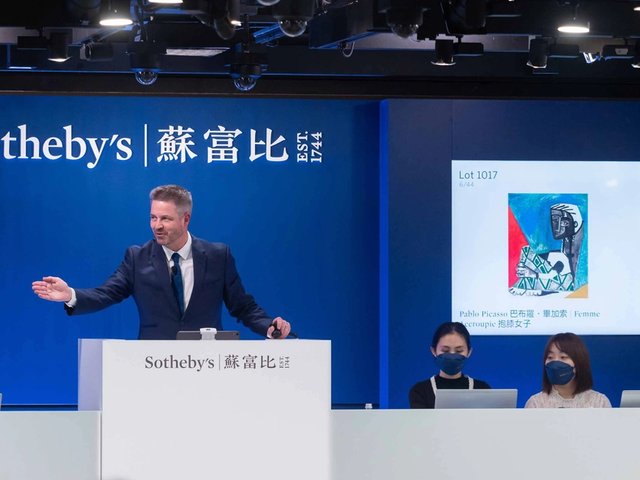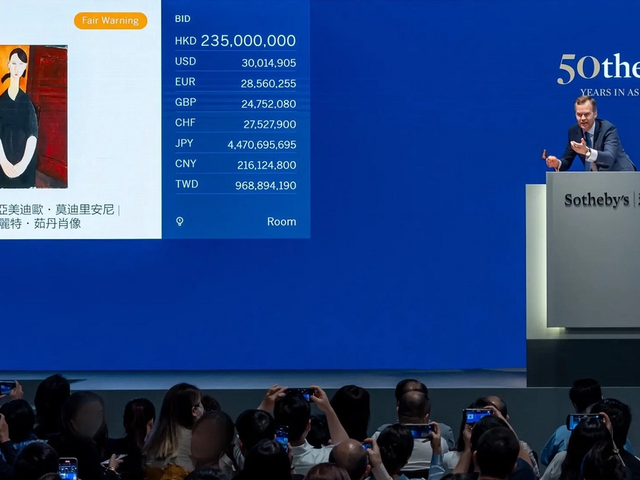Sotheby’s cleverly billed the 3 April sale in Hong Kong of 105 works from the collection of Baron Guy Ullens, the Belgian foodstuffs magnate, as “The Nascence of Avant-Garde China”. With such an air of importance, the sale was aggressively marketed with a six-city tour, a hardback catalogue and a museum-style display at the Hong Kong preview.
Within the first hour, Zhang Xiaogang’s Forever Lasting Love (undated), three paintings of eerie human figures packaged as a triptych, lived up to the hype and its carefully assigned 808 lot number (a lucky number in China): after a bout of heated phone bids, the lot went under the hammer to an anonymous buyer on the phone for just over HK$79m ($10m; est HK$25m-HK$30m). This new record for a work of contemporary Chinese art was applauded by the 500 or so in the saleroom at the Hong Kong Convention and Exhibition Centre.
The four-hour, “white glove” sale (in which all the lots find buyers) brought in a total of HK$427m ($54.8m; est HK$100m-HK$130m), and a pair of ceremonial white gloves was presented to auctioneer Henry Howard-Sneyd, vice chairman of Asian art, at the end.
Twelve works went for over HK$10m ($1.3m), with records set for several artists. Zhang Peili’s 1986 oil-on-canvas “Series X?” No 3, 1986, sold for HK$23m (almost $3m, est HK$1.5m-HK$2m). The catalogue cover piece, Wang Guangyi’s Mao Zedong: P2, 1988, was bought by a private American collector for HK$19m ($2.5m). Records were also established for Geng Jianyi, Ding Yi, Yu Youhan and Liu Wei.
“This is a good representation of where the market is at the moment. There is a lot of money out there and people are willing to pay top prices for important works. If you have access to funds, you buy a seminal piece with great provenance because it will only increase in value,” Jonathan Crockett, a Hong Kong independent art adviser, said. He cited two Ding Yi abstracts as examples: a bidder in the room paid HK$17.5m ($2.3m) for the artist’s Appearance of the Crosses 90-6, a 1990 piece where the pattern was created by the handling of the acrylic paint. The next lot, Appearance of Crosses 97-5, a similar-looking 1997 work on tartan fabric, only sold for HK$1.2m ($155,000). “It is a matter of material, the age and the medium,” Crockett said.
While much has been made of mainland Chinese buyers and the millions they are willing to pay, they did not drive the high prices at this sale. “These kinds of works are not to the taste of Chinese industrialists, many of whom still prefer realism,” said Kai-yin Lo, a Hong Kong-based member of the Tate Modern Asian art acquisition committee.
While several Southeast Asian, Hong Kong and Taiwan collectors were bidding, no mainland buyer was credited for any of the top ten purchases. Zhang’s Forever… is believed to have been purchased by an American or European. Acquavella New York was identified as the buyer of Zeng Fanzhi’s Mask Series No. 4, 1994, for HK$16.9m ($2.2m), the eighth most expensive lot.
Ullens still has over 1,000 pieces in his Chinese collection, which ranges from classic Chinese ink master works to more contemporary fare. The Sotheby’s sale was a taster and a teaser—following the record-breaking buzz—for the further disposal of Ullens’ assets. A second Ullens auction at Sotheby’s is widely believed to be in the works for the autumn, although the auction house would not confirm this.
In early June, Beijing’s Poly Auction will sell 34 contemporary works from Ullens, edited for mainland tastes to include works such as a romantic realist painting of Tibetan nomads by the late Chen Yifei.
Originally appeared in The Art Newspaper as ‘Ullens collection’s lucky numbers'



